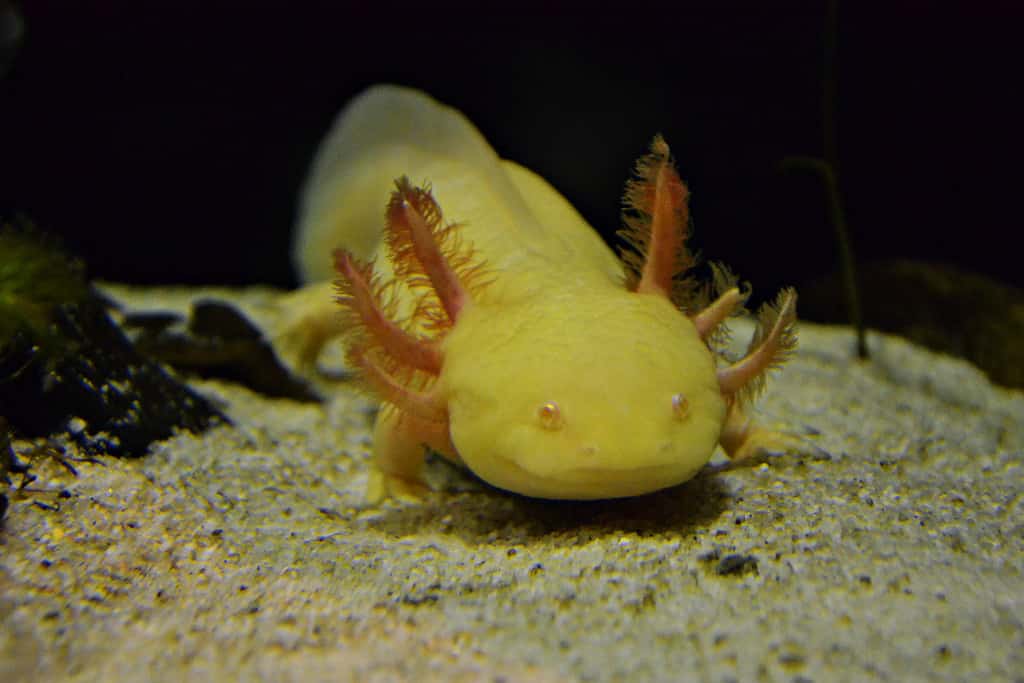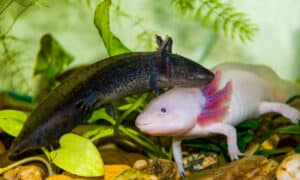Axolotls are perhaps one of the most difficult exotic pets to care for properly. And, of course, this was the animal my friend chose for her first exotic. This Mexican native is a paedomorphic salamander that never loses its gills and lives its entire life in the water. It’s the Peter Pan of salamanders that never really wants to grow up, so it doesn’t.
The unique living accommodations of this particular salamander make taking care of an axolotl especially difficult. Like a fish, you must cycle the water before you introduce your new baby into the aquarium. It also has certain other needs and limitations, which if you expect and are ready for, are achievable. But if you aren’t ready, it can be disastrous.
I’ve changed her name because she is a very private person, but this is her story.
The Axolotl Allure

Axolotls never completely “grow up” and keep their gills for life.
©iStock.com/Lucia Martini
I have never owned an axolotl and probably never will. The idea of keeping anything that needs to live in, and breathe water terrifies me! I get too attached and, if we’re being honest, I’m not fastidious enough with fully aquatic enclosures like the axolotl needs.
But, there’s a certain allure to something that never wants to grow up. Call me Petra Pan, but I dig the idea. So, when my friend Jeanie decided she wanted one, I was more than happy to help her find an axolotl and learn to care for it because what’s wrong with living vicariously sometimes?
Challenges Are Good, Right?
Right off the bat, I was concerned. As we started learning about this nine to 12-inch-long salamander that lives underwater, any ideas of me ever adopting an axolotl flew out the window. Jeanie, however, was undeterred.
She loved how delicate and sensitive these little water sprites were and convinced herself the challenge was worth it. In all honesty, she was in love with axolotls. And who could blame her? They are downright adorable little freaks of nature. Unfortunately, they’re critically endangered. The tiny little pocket of brackish water where they live may only support about 1,000 of them. These salamanders are native to a few lakes under what is now Mexico City. Spanish settlers drained the lakes and destroyed much of their natural habitat. The remnant of Lake Xochimilco is the last remaining habitat for axolotls.
The sad, but hopeful irony is that while the wild populations dwindle because of pollution and habitat loss, worldwide breeders are keeping the species going. It may not be long before the only place they’ll exist is in homes and zoos. Certainly, part of Jeanie’s axolotl interest was because she could contribute to perpetuating the species in a small, but real way.
A Little Obsession Goes a Long Way
Jeanie went all out in getting a tank, substrate, and all sorts of paraphernalia for her soon-to-arrive pet axolotl. She carefully picked out plants, rocks, some very pretty sparkly sand, and a 20-gallon tank that would fit perfectly in her home office near her computer desk.
Before she went to pick up her new axolotl friend, an adult she was naming Oscar, Jeanie set up the aquarium. She spent a couple of weeks cycling the water, doing partial changes, testing it, you name it. My friend was positively obsessed! It looked like everything was ready.
That is unless you know anything about axolotl care and keeping.
Oscar the Injured Axolotl
Axolotls are sensitive. Their skin gets cut up easily and sand substrate, while generally good for them, must be chosen carefully. Sometimes they ingest it when they eat and sometimes the particles are too big to pass through their digestive system safely. Some sand particles have sharp edges that can injure them both internally and externally.
Very fine play sand is acceptable for them, but that’s not what Jeanie had. Her sand was shiny and sparkly. It was beautiful, but in hindsight was the wrong choice. She discovered that sparkly sand like her substrate, is crushed rock and quartz, full of sharp jagged edges. It was dangerous!
Oscar almost immediately had cuts all over the place and she could not figure out why. So, she called up the breeder (who, in hindsight, wasn’t the most responsible of breeders). They explained a little about their skin and where she went wrong. So, she removed the crushed quartz and rock substrate and left the aquarium bottom bare while Oscar healed. Fortunately, although there were quite a few cuts and scrapes, mostly around the snout and along the belly, they healed quickly.
After all, axolotls can regenerate body parts, even internal organs! So as long as you’re taking steps to care for them properly, axolotls can actually tolerate a bit of struggle.
One Thing After Another for Oscar the Axolotl
Poor Oscar could not catch a break. Wild axolotl’s water stays between 57ºF and 68ºF all year, so most experts recommend staying well within that range. Most people use a variety of cooling options, from cooling fans that blow across the surface to aquarium water chillers, a pricey but functional choice. Jeanie lived in a hot, humid city in the south and had frequent air conditioning problems, but she figured the cooling fans would be enough.
When Jeanie bought everything for Oscar’s aquarium, she looked at the cost difference between cooling fans and aquarium chillers and figured the fans would be enough. Jeanie also decided on the smaller aquarium to save a few dollars initially, because the breeder was rushing her to pick up Oscar.
However, axolotls produce a lot of bio-waste. Their water gets dirty, full of nitrites, and unhealthy fast. That’s part of the reason that many reputable breeders recommend at least a 40-gallon aquarium. Aside from that, axolotls like to explore and need plenty of room to stay active. The larger aquarium size also means more stable everything with both the water quality and its temperature.
A Perfect Storm
When a heatwave struck early that spring, Jeanie’s air conditioning broke down. It was an older unit and she knew it was on the way out. But, it would be several days before a company could get to her home to replace it. Everyone needed their air conditioners serviced.
Between the heatwave and broken A/C, keeping the temperatures down in the aquarium, and the water quality, Jeanie was at her wit’s end and terrified she’d lose her precious little axolotl. She called me, in tears, saying, “I was so not ready for Oscar! I adopted an axolotl and now he’s going to die because I messed up!”
I dropped what I was doing and went to see her. She wasn’t kidding, poor Oscar’s tank was filthy, but not because she hadn’t tried. Axolotls are notorious for fouling a tank quickly. That tiny little 20-gallon tank just wasn’t enough. She had even made ice cubes out of his water to keep the water cool.
But, in true amazing Jeanie fashion, she lept to action, dragging me to the pet supply store so she could get a bigger aquarium, get the aquarium chiller, and some big river rock gravel for the new substrate.
A Happy Ending After Turmoil
In the end, we were able to save Oscar. He lived a pretty good life for axolotl and reached the venerable age of 16 (or so) when he finally passed away. After the initial terror with keeping Oscar alive, Jeanie was able to get everything stabilized. She was able to almost intuit when something was “off” in his (her?) aquarium.
For me? I still wouldn’t keep one. I’d rather visit other people’s axolotls. They’re really cute salamanders.
The photo featured at the top of this post is © Andrea Izzotti/Shutterstock.com
Thank you for reading! Have some feedback for us? Contact the AZ Animals editorial team.






